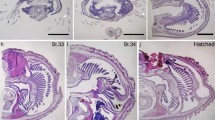Abstract
Species of the suborder Notothenioidei dominate the fish fauna of coastal Antarctic waters. Members of one notothenioid family, Channichthyidae (Antarctic icefishes), are unique among all vertebrates in lacking the circulating oxygen-binding protein hemoglobin. Icefish species also do not uniformly express the intracellular oxygen-binding protein myoglobin (Mb) in their oxidative muscles. Our laboratory previously characterized the pattern of cardiac Mb expression in 13 of the 16 known icefish species. In this paper, we complete the survey of cardiac Mb expression among all 16 known species of icefishes. Using PAGE and immunoblot analyses, we demonstrate that both Channichthys rhinoceratus and Cryodraco atkinsoni express Mb in heart ventricle, while Champsocephalus esox does not express the protein. We report Mb gene sequences from Channichthys rhinoceratus and Champsocephalus esox genomic DNA. The Mb gene of C. esox contains the identical 5-bp duplication/insertion to that observed in congeneric Champsocephalus gunnari, a species that also does not produce Mb. This duplication in exon 2 of the Champsocephalus spp. gene causes a shift in reading frame at a position normally encoding for amino acid 91 and also results in a premature stop codon, thus disrupting translation of the normal protein. Thus, 6 of the 16 known icefish species do not express cardiac Mb. These results confirm earlier conclusions that losses of Mb expression have occurred via at least four independent events during the evolution of the icefish family. Extreme similarity of Mb genes in Champsocephalus congeners further suggests recent speciation despite early divergence of this group from the lineage leading to more derived icefishes.




Similar content being viewed by others
References
Di Prisco G, Cocca E, Parker SK, Detrich HW III (2002) Tracking the evolutionary loss of hemoglobin expression by the white-blooded Antarctic icefishes. Gene 295:185–191
Eastman JT (1993) Antarctic fish biology: evolution in a unique environment. Academic, San Diego
La Mesa M, Vacchi M, Iwami T, Eastman JT (2002) Taxonomic studies of the Antarctic icefish genus Cryodraco Dollo, 1900 (Notothenioidei: Channichthyidae). Polar Biol 25: 384–390
Moylan TJ, Sidell BD (2000) Concentrations of myoglobin and myoglobin mRNA in heart ventricles from Antarctic fishes. J Exp Biol 203:1277–1286
Near TJ (2004) Estimating divergence times of notothenioid fishes using a fossil-calibrated molecular clock. Antarct Sci (in press)
Near TJ, Pesavento JJ, Cheng C-HC (2003) Mitochondrial DNA, morphology, and the phylogenetic relationships of Antarctic icefishes (Notothenioidei: Channichthyidae). Mol Phylogenet Evol 28:87–98
Ruud JT (1954) Vertebrates without erythrocytes and blood pigment. Nature 173:848–850
Schägger J, von Jagow G (1987) Tricine-sodium dodecyl sulfate-polyacrylamide gel electrophoresis for the separation of proteins in the range from 1 to 100 kDa. Anal Biochem 166:268–379
Sidell BD (1998) Intracellular oxygen diffusion: the roles of myoglobin and lipid at cold body temperature. J Exp Biol 201:1118–1127
Sidell BD, Vayda ME, Small DJ, Moylan TJ, Londraville RL, Yuan M-L, Rodnick KJ, Eppley ZA, Costello L (1997) Variable expression of myoglobin among the hemoglobinless Antarctic icefishes. Proc Natl Acad Sci U S A 94:3420–3424
Small, DJ, Vayda ME, Sidell BD (1998) A novel vertebrate myoglobin gene containing three A+T-rich introns is conserved among Antarctic teleost species which differ in myoglobin expression. J Mol Evol 47:156–166
Stankovic A, Spalik K, Kamler E, Borsuk P, Weglenski P (2002) Recent origin of sub-Antarctic notothenioids. Polar Biol 25:203–205
Vayda ME, Small DJ, Yuan M-L, Costello, L, Sidell BD (1997) Conservation of the myoglobin gene among Antarctic notothenioid fishes. Mol Mar Biol Biotech 6:207–216
Acknowledgements
We thank the Master, crew and Raytheon Polar Services (RPSC) support personnel of the A.R.S.V. “Laurence M. Gould” and RPSC support staff of U.S. Palmer Station, Antarctica without whom our fieldwork would be impossible. We also gratefully acknowledge generous gifts of tissues from Dr. A. North (UK), Dr. G. Duhamel (France) and Dr. T. Iwami (Japan), which permitted us at long last to complete the survey of the Channichthyidae. This research was supported by US National Science Foundation grants OPP 99–09055 and 01–25890 to BDS.
Author information
Authors and Affiliations
Corresponding author
Rights and permissions
About this article
Cite this article
Grove, T.J., Hendrickson, J.W. & Sidell, B.D. Two species of antarctic icefishes (genus Champsocephalus) share a common genetic lesion leading to the loss of myoglobin expression. Polar Biol 27, 579–585 (2004). https://doi.org/10.1007/s00300-004-0634-0
Received:
Revised:
Accepted:
Published:
Issue Date:
DOI: https://doi.org/10.1007/s00300-004-0634-0




